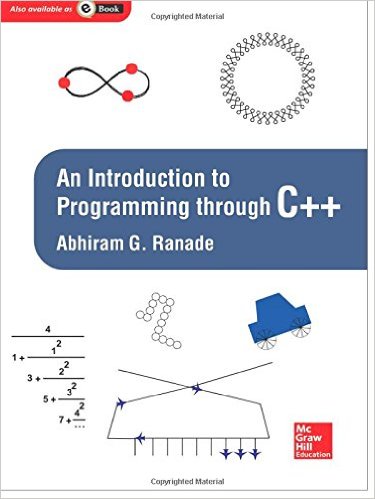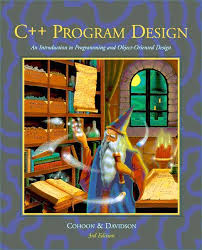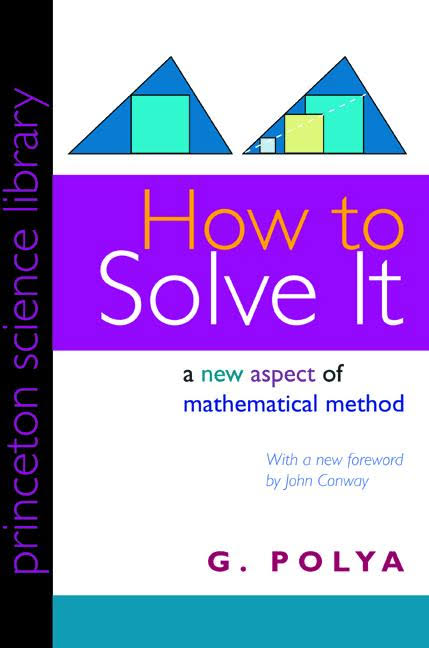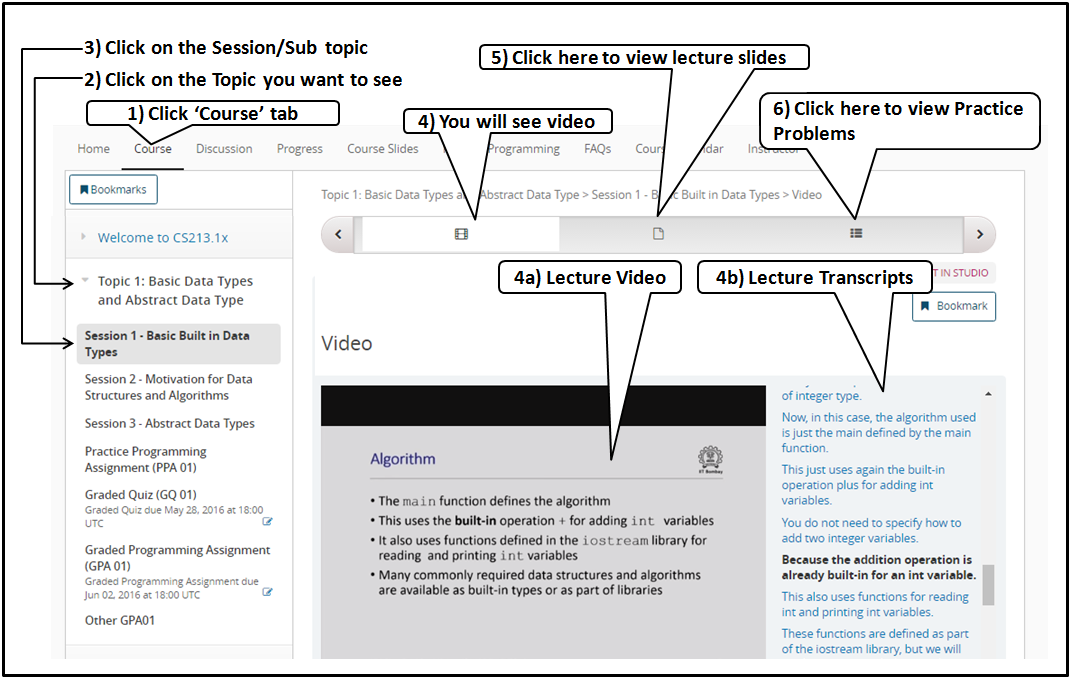FAQs (Frequently Asked Questions)
- Which textbooks/reading material should I refer?
 |
 |
 |
 |
 |
| Introduction to Problem Solving and Programming through C++ by Abhiram Ranade, |
C++ Program Design: An introduction to Programming and Object-Oriented Design by Cohoon and Davidson, 3rd Edition, Tata McGraw Hill |
Thinking in C++ by Bruce Eckel |
How to Solve It by Computer by G. Dromey, Prentice-Hall |
How to Solve It by Polya G., Princeton University Press |
- How do I navigate through this platform?

- How do I browse this course?

- Which OS (Operating System) do I need to use. Is Ubuntu compulsory?
Yes, you can use any Operating System or Programming IDEs that you like. There is fundamentally no difference if you use any OS (Linux, Unix, Mac OS, BSD, QNX, Windows, etc.). The whole point is to learnprogramming and solve some interesting problems. There is some material in 'Welcome to CS101.1x' whichis specifically released for participants who are keen in using and exploring the power of Open Source software. However, you are free to use any free or proprietary software. - What is a topic and what does it comprise of?
This course is divided into different concepts called 'Topics'. There are 6 topics in this course. Each Topic generally consists of the following: - Sessions: Consisting of lecture videos, lecture transcripts, lecture slides, and Practice Problem Set (PPS)
- Graded Quiz (GQ)
- Graded Programming Assignment (GPA)
- When does the course end?
This course, CS213.1x - Foundation of Data Structures, is asix week course. It ends on Tuesday, 12 December 2017 - What are practice problem sets (PPS) and how will they help me? Where do I find them?
Practice Problem Sets (PPS) are non-graded quiz questions for you to practice. They contain MCQs (Multiple Choice Questions), Numeric Questions, orText based questions. There will not be any deadline for these, but you are expected to solve these for your own practice andunderstanding, so that you can attempt the graded quizzes with better preparation. They are presentunder every session (following the Lecture Slides) - How many graded quizzes (GQs) are there in this course and where do I find them?
There are 6 graded quizzes of which the marks that you score in the best 4 quizzes will be considered, i.e. GQs having the lowest 2 scores will be dropped. They are present under all 6 topics (after all the sessions of the topic). These will be displayed according to the date of release. See the 'Course Calendar' for more details. Codeboard - What is
Codeboard Codeboard .io is a web based IDE for compiling and executing your C++ programs. - How do I practice and execute programs?
Codeboard is set up as a codebase titled 'Practice Programming' for you to practice your programs. You can write your programs, compile, and execute them. The output of your program will be displayed to you. Click here to directly go to the link. - What do I do after I execute code in 'Practice Programming' codebase?
After you write, compile, and execute your programs, you can either close or save it. Please note that if you refresh your browser, the code that you have written will be lost. If you want to save your code, then you will need to register and sign in on 'https://codeboard.io/'. - What are PPAs and how will they help me? Where do I find them?
PPAs are Practice Programming Assignments. A problem definition is provided and you need to write your solution program. These will help you in solving problems and improve your coding skills. You will be notified as and when they are made available. - Do I need to submit the code that I write for PPAs
Since these are non-graded programming assignments, you don't have to submit them. You can compile and execute your program. Appropriate results and score will be displayed to you. Please read the instructions given in every PPA. - What are GPAs and where do I find them?
GPAs are Graded Programming Assignments. Similar to PPAs, we will provide problem definition to you. You are required to write your solution code, compile, and execute them. The instructions will be given in respective GPAs. GPAs are present under all 6 topics (just after GQs). - How do I submit the code for grading that I write for GPA?
After you compile and run your program, you are required to click the 'Submit' button, which is present next to 'Run' button. - How will I come to know that my program has been submitted for grading? How do I see my grade for that GPA?
After you click the submit button, a statement stating 'You solution was successfully submitted' will be displayed. Your grade will not be reflected. Toreflect / view your grade, you will need to Refresh your browser. Make sure that you have saved your program either oncodeboard or somewhere on your local disk. This is because, when you refresh your browser the code that you had written will be lost. - Apart from Graded Quizzes (GQ) and Graded Programming Assignments (GPA), do I need to submit anything else for grading?
Yes, apart from GQs and GPAs, you also need to answer and submitMid Term Exam (ME) and Final Examination (FE). - What is the weight-age scheme for graded assessments?
Graded Quizzes (GQ) : 36%
Graded Programming Assignments (GPA) : 24%
Mid Term Examination (ME) : 20%
Final Examination (FE) : 20%
------------------------------------------------
Total : 100%
------------------------------------------------ - What is the deadline for submitting my graded assessments?
The deadline for submitting is as follows:GQs : 2 days from the date of releaseGPAs : 1 week from the date of releaseME : 17 June 2016FE : 8 July 2016 - How do I monitor my progress?
You can check your progress by clicking on the 'Progress' tab in the top panel.